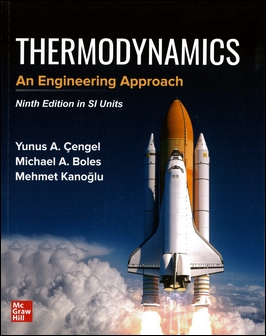(eBook) Thermodynamics: An Engineering Approach 9/e (SI Units)
- ◉ VitalSource◉ 閱讀期限:Lifetime
售價
$
1,000
- 電子書
- ISBN:9789814821575
- 作者:Yunus Cengel, Michael A. Boles, Mehmet Kanoglu
- 版次:9
- 年份:2020
- 出版商:McGraw-Hill
- 頁數/規格:電子書
書籍介紹
本書特色
目錄
作者介紹
►VitalSource 電子書購買須知:
Description
Distinguished as a best seller, the title Thermodynamics: An Engineering Approach is taking another step towards excellence with this revised edition. Through its careful explanations of concepts and use of numerous practical examples and figures, this book aims to bridge the gap between knowledge and application.
About the Cover
The launch of a space shuttle occurs with the help of a rocket. Operation of a rocket engine is an exemplary application of thermodynamics, which involves a sequence of thermodynamic processes. The chemical energy that s stored in the fuel of the rocket engine is first converted into thermal energy and then kinetic energy. As the rocket climbs higher into the atmosphere, some of that kinetic energy get stored as gravitational potential energy. In addition, the combustion products (gases) accelerate through a converging-diverging nozzle to supersonic speeds in accordance with the first and second laws of thermodynamics. This provides the net positive thrust against the air drag, which propels the rocket in the opposite direction.
- 閱讀期限:Lifetime
- 電子書兌換碼將於 3-5 個工作天,寄送至「序號寄送 E-mail」所填寫的信箱。
- 根據消費者保護法第 19 條第 1 項規定,本產品為數位內容,售出後恕不接受退貨或退款。
- 本產品僅限台灣境內使用,海外 IP 無法註冊或啟用。
- 電子書平台登錄與註冊說明 (eText-Register.pdf)。
- 電子書平台操作手冊 (eText-Manual.pdf)。
- 如有任何問題,請 Email 至 ebook@tunghua.com.tw。
Description
Distinguished as a best seller, the title Thermodynamics: An Engineering Approach is taking another step towards excellence with this revised edition. Through its careful explanations of concepts and use of numerous practical examples and figures, this book aims to bridge the gap between knowledge and application.
About the Cover
The launch of a space shuttle occurs with the help of a rocket. Operation of a rocket engine is an exemplary application of thermodynamics, which involves a sequence of thermodynamic processes. The chemical energy that s stored in the fuel of the rocket engine is first converted into thermal energy and then kinetic energy. As the rocket climbs higher into the atmosphere, some of that kinetic energy get stored as gravitational potential energy. In addition, the combustion products (gases) accelerate through a converging-diverging nozzle to supersonic speeds in accordance with the first and second laws of thermodynamics. This provides the net positive thrust against the air drag, which propels the rocket in the opposite direction.
Key Features
- Written in a self-instructive manner, it speaks to students, not over students
- Emphasises on the physical aspects of the subject matter in addition to mathematical representations and manipulations
- Follows a physical, intuitive approach to help students master the practical problems
- Contains a rich pool of pedagogy which revolve around the real-world problems
Table of Contents
1) Introduction and Basic Concepts
2) Energy, Energy Transfer, and General Energy Analysis
3) Properties of Pure Substances
4) Energy Analysis of Closed Systems
5) Mass and Energy Analysis of Control Volumes
6) The Second Law of Thermodynamics
7) Entropy
8) Exergy
9) Gas Power Cycles
10) Vapor and Combined Power Cycles
11) Refrigeration Cycles
12) Thermodynamic Property Relations
13) Gas Mixtures
14) Gas-Vapor Mixtures and Air-Conditioning
15) Chemical Reactions
16) Chemical and Phase Equilibrium
17) Compressible Flow
1) Introduction and Basic Concepts
2) Energy, Energy Transfer, and General Energy Analysis
3) Properties of Pure Substances
4) Energy Analysis of Closed Systems
5) Mass and Energy Analysis of Control Volumes
6) The Second Law of Thermodynamics
7) Entropy
8) Exergy
9) Gas Power Cycles
10) Vapor and Combined Power Cycles
11) Refrigeration Cycles
12) Thermodynamic Property Relations
13) Gas Mixtures
14) Gas-Vapor Mixtures and Air-Conditioning
15) Chemical Reactions
16) Chemical and Phase Equilibrium
17) Compressible Flow
Table of Contents
1) Introduction and Basic Concepts
2) Energy, Energy Transfer, and General Energy Analysis
3) Properties of Pure Substances
4) Energy Analysis of Closed Systems
5) Mass and Energy Analysis of Control Volumes
6) The Second Law of Thermodynamics
7) Entropy
8) Exergy
9) Gas Power Cycles
10) Vapor and Combined Power Cycles
11) Refrigeration Cycles
12) Thermodynamic Property Relations
13) Gas Mixtures
14) Gas-Vapor Mixtures and Air-Conditioning
15) Chemical Reactions
16) Chemical and Phase Equilibrium
17) Compressible Flow
1) Introduction and Basic Concepts
2) Energy, Energy Transfer, and General Energy Analysis
3) Properties of Pure Substances
4) Energy Analysis of Closed Systems
5) Mass and Energy Analysis of Control Volumes
6) The Second Law of Thermodynamics
7) Entropy
8) Exergy
9) Gas Power Cycles
10) Vapor and Combined Power Cycles
11) Refrigeration Cycles
12) Thermodynamic Property Relations
13) Gas Mixtures
14) Gas-Vapor Mixtures and Air-Conditioning
15) Chemical Reactions
16) Chemical and Phase Equilibrium
17) Compressible Flow



